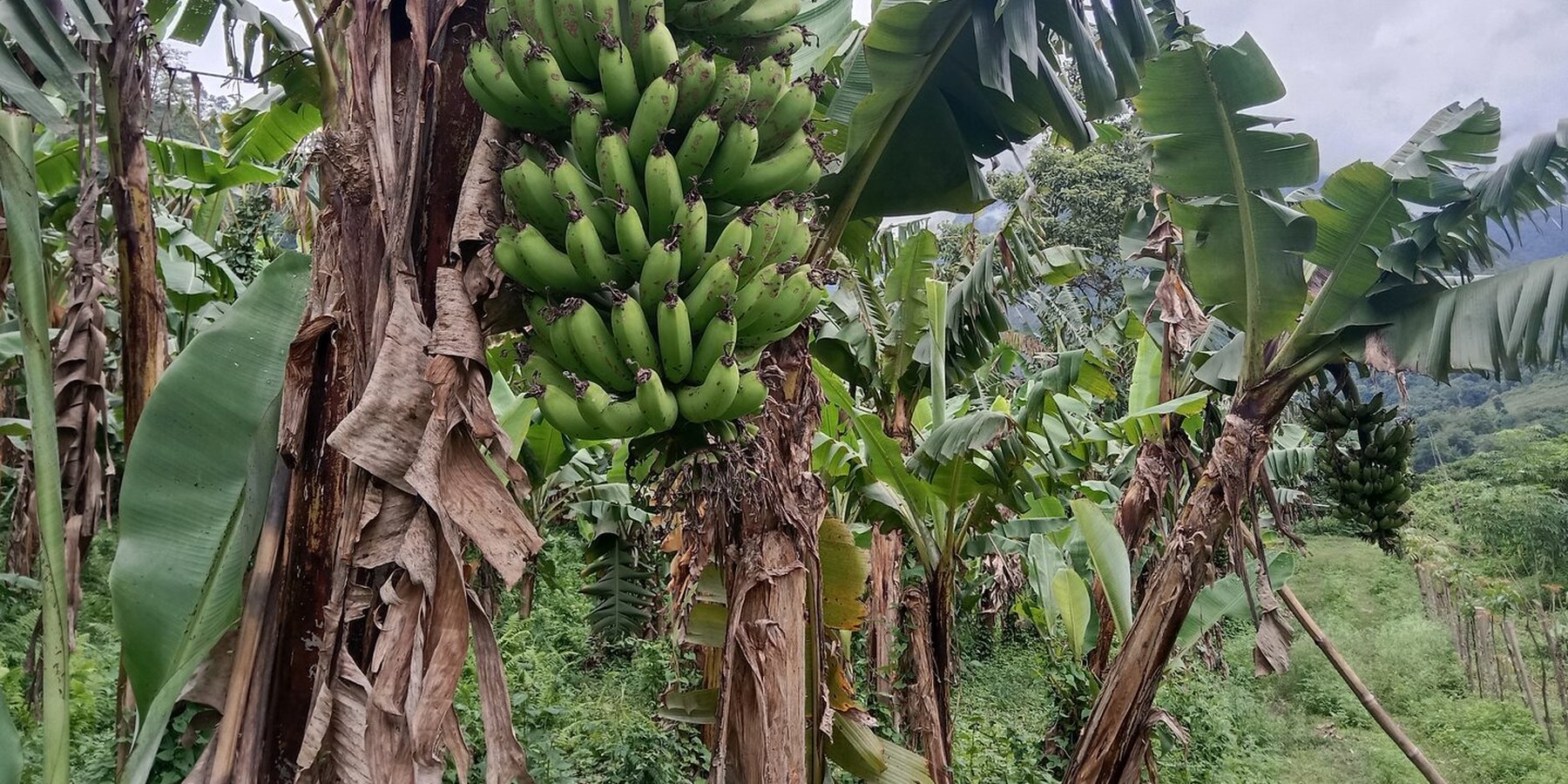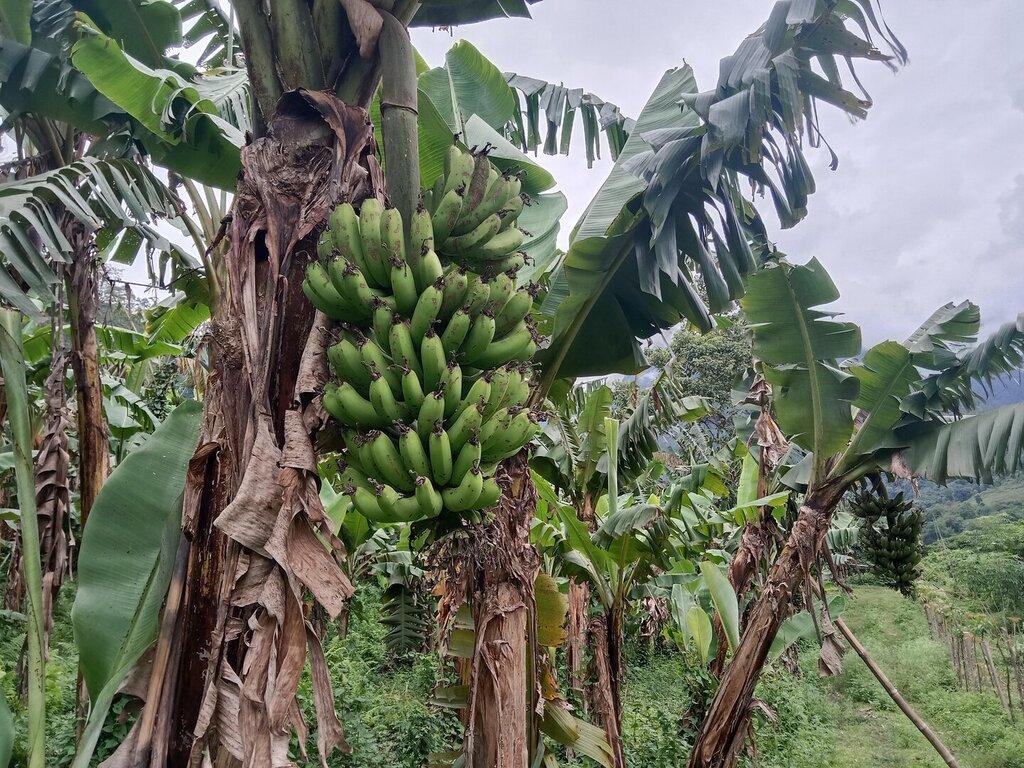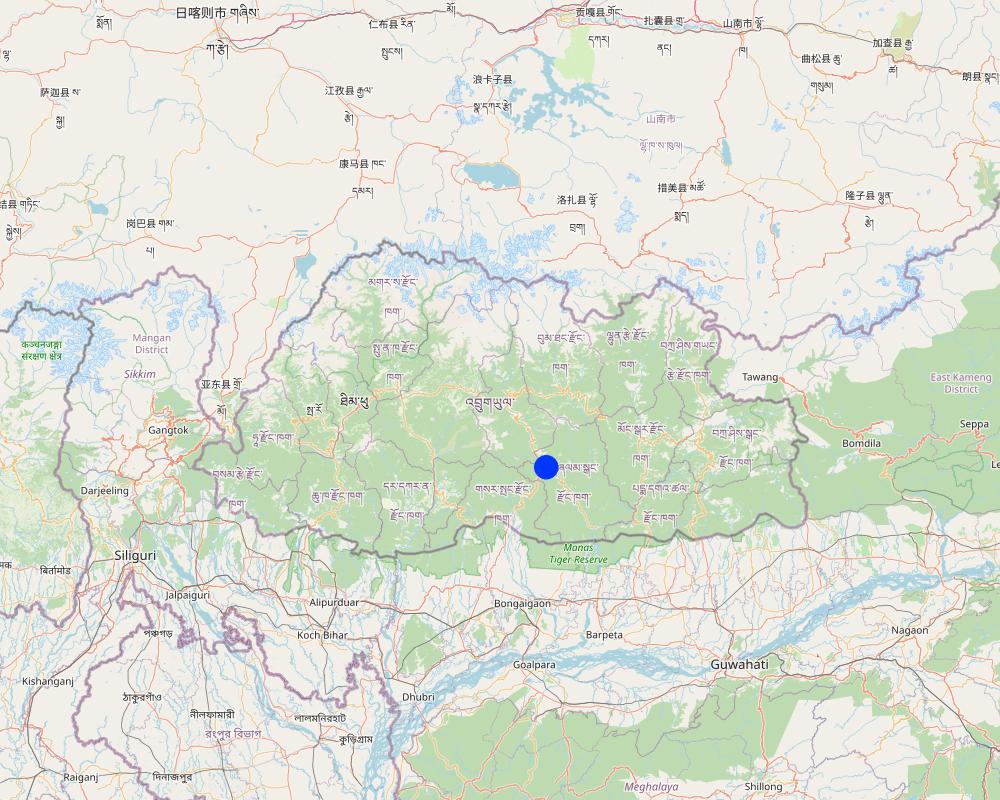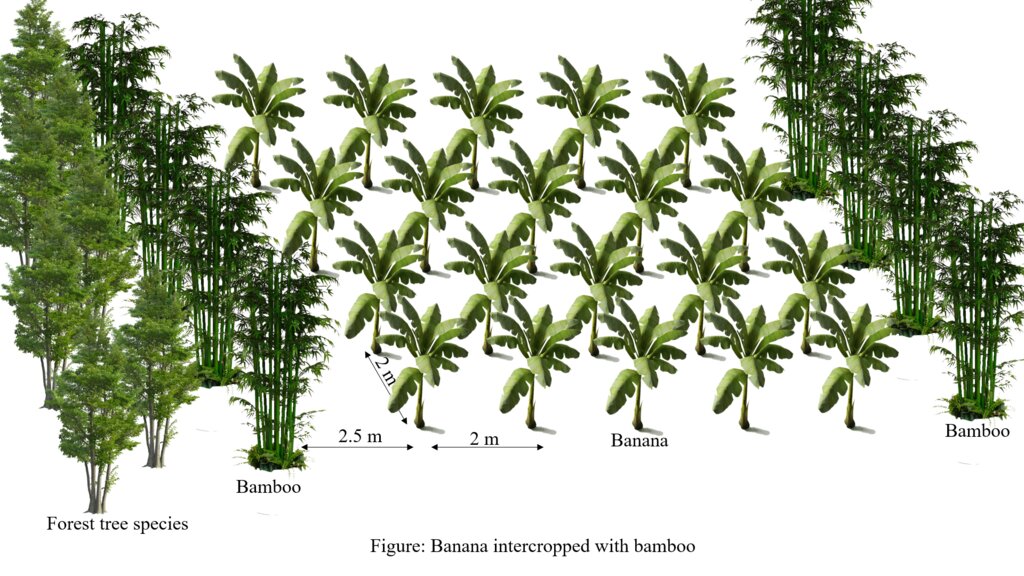Rehabilitation of Fallow Land Through Agroforestry [ภูฏาน]
- ผู้สร้างสรรค์:
- การอัพเดท:
- ผู้รวบรวม: Nima Dolma Tamang
- ผู้เรียบเรียง: Tashi Wangdi
- ผู้ตรวจสอบ: William Critchley, Rima Mekdaschi Studer
Sa Tong Lar Log
technologies_6839 - ภูฏาน
ดูส่วนย่อย
ขยายทั้งหมด ย่อทั้งหมด1. ข้อมูลทั่วไป
1.2 รายละเอียดที่ติดต่อได้ของผู้รวบรวมและองค์กรที่เกี่ยวข้องในการประเมินและการจัดเตรียมทำเอกสารของเทคโนโลยี
วิทยากรหลัก
ผู้ใช้ที่ดิน:
Zangpo Dawa
Khengrig Namsum Cooperative
ภูฏาน
ผู้ใช้ที่ดิน:
Wangmo Tashi
Khenrig Namsum Cooperative
ภูฏาน
ผู้ใช้ที่ดิน:
Wangmo Pema
Khenrig Namsum Cooperative
ภูฏาน
ผู้ใช้ที่ดิน:
Dolkar Tshering
Khenrig Namsum Cooperative
ภูฏาน
ชื่อของโครงการซึ่งอำนวยความสะดวกในการทำเอกสารหรือการประเมินเทคโนโลยี (ถ้าเกี่ยวข้อง)
Strengthening national-level institutional and professional capacities of country Parties towards enhanced UNCCD monitoring and reporting – GEF 7 EA Umbrella II (GEF 7 UNCCD Enabling Activities_Umbrella II)ชื่อขององค์กรซึ่งอำนวยความสะดวกในการทำเอกสารหรือการประเมินเทคโนโลยี (ถ้าเกี่ยวข้อง)
National Soil Services Centre, Department of Agriculture, Ministry of Agriculture & Livestock (NSSC) - ภูฏาน1.3 เงื่อนไขการใช้ข้อมูลที่ได้บันทึกผ่านทาง WOCAT
ผู้รวบรวมและวิทยากรหลักยอมรับเงื่อนไขเกี่ยวกับการใช้ข้อมูลที่ถูกบันทึกผ่านทาง WOCAT:
ใช่
1.4 การเปิดเผยเรื่องความยั่งยืนของเทคโนโลยีที่ได้อธิบายไว้
เทคโนโลยีที่ได้อธิบายไว้นี้เป็นปัญหาของความเสื่อมโทรมโทรมของที่ดินหรือไม่ จึงไม่ได้รับการยอมรับว่าเป็นเทคโนโลยีเพื่อการจัดการที่ดินอย่างยั่งยืน:
ไม่ใช่
แสดงความคิดเห็น:
As per the responses made by the land users (cooperative representatives), the rehabilitation of fallow land through agroforestry has been a successful SLM indicator towards mitigating and adapting land degradation, securing food, and ultimate livelihood enhancement.
2. การอธิบายลักษณะของเทคโนโลยี SLM
2.1 การอธิบายแบบสั้น ๆ ของเทคโนโลยี
คำจำกัดความของเทคโนโลยี:
Fallow is arable land deliberately set aside due to challenges faced in cultivation. The rehabilitation of lands left fallow for decades through the adoption of agroforestry has been one success story of the Khengrig Namsum Cooperative in the central region of Bhutan. The integration of perennial trees (fruit and high-value trees) and seasonal crops creates environmental, economic, and social benefits.
2.2 การอธิบายแบบละเอียดของเทคโนโลยี
คำอธิบาย:
Fallow land is the term for arable fields either partially or completely left unused and unproductive, owing to reasons such as labour shortages, lack of irrigation, human-wildlife conflict and/or the plots being far away from the settlements. Land rehabilitation is a promising approach towards mitigating the fallow land issue. Thus, the Khengrig Namsum Cooperative (KNC), a registered firm under the Department of Agriculture Marketing and Cooperatives, Ministry of Agriculture and Livestock (MoAL), Bhutan has ventured into rehabilitating 235 acres (94 ha) of fallow lands since 2016, through the adoption of agroforestry. The KNC was founded by Mr. Thinley Wangdi (the current chairman), with the motive of improving the livelihoods of the people of Zhemgang Dzongkhag through locally grown farm produce.
The KNC with funds from the Global Environment Facility - Small Grant Program (GEF–SGP) through the United Nations Development Program (UNDP), Bhutan, revived the fallow through agroforestry (intercropping of banana and bamboo plants). The KNC intervened in three strategic locations, benefitting 36 households. This particular agroforestry approach was not only aimed towards enhancing livelihoods but also to diversify production: through banana chips production and bamboo product development.
Upon securing the funds, implementation started with the procurement of planting and fencing materials, hands-on training, and then planting and fencing activities. Installation of electric fencing was done to reduce human-wildlife conflict. There was specific training on product development. Moreover, the KNC was able to link up with nearby schools for the school feeding programme, to supply fruits and vegetables. The cooperative demonstrates skills in processing its own products and enabling better access to renewable natural resources in the locality. On the contrary, not having proper cold storage facilities has negative impacts on processing units and has resulted in unreliable market coupling.
2.3 รูปภาพของเทคโนโลยี
2.5 ประเทศภูมิภาค หรือสถานที่ตั้งที่เทคโนโลยีได้นำไปใช้และได้รับการครอบคลุมโดยการประเมินนี้
ประเทศ:
ภูฏาน
ภูมิภาค/รัฐ/จังหวัด:
Zhemgang Dzongkhag
ข้อมูลจำเพาะเพิ่มเติมของสถานที่ตั้ง :
Rebati Chiwog under Ngangla Gewog, Brumbi and Jiwongolia Chiwog under Trong Gewog
ระบุการกระจายตัวของเทคโนโลยี:
- กระจายไปอย่างสม่ำเสมอในพื้นที่
If the Technology is evenly spread over an area, specify area covered (in km2):
0.95
Is/are the technology site(s) located in a permanently protected area?
ไม่ใช่
Map
×2.6 วันที่การดำเนินการ
ระบุปีที่ใช้:
2015
2.7 คำแนะนำของเทคโนโลยี
ให้ระบุว่าเทคโนโลยีถูกแนะนำเข้ามาอย่างไร:
- ทางโครงการหรือจากภายนอก
ความคิดเห็น (ประเภทของโครงการ เป็นต้น) :
The implementation of activity in Rebati and Brumbi started in 2016, whereas for Jiwongolia, it started in the year 2019. The Global Environment Facility - Small Grant Program (GEF-SGP) under the United Nations Development Program (UNDP) has funded the program in the Rebati and Brumbi communities. Likewise, the Bhutan Foundation and the HELVETAS have funded the programme in Jiwongolia. The fallow land rehabilitation program was the initiative of Khengrig Namsum Cooperative.
3. การจัดประเภทของเทคโนโลยี SLM
3.1 วัตถุประสงค์หลักของเทคโนโลยี
- ปรับปรุงการผลิตให้ดีขึ้น
- ลด ป้องกัน ฟื้นฟู การเสื่อมโทรมของที่ดิน
- รักษาสภาพหรือปรับปรุงความหลากหลายทางชีวภาพ
- สร้างผลกระทบทางด้านเศรษฐกิจที่เป็นประโยชน์
- สร้างผลกระทบทางด้านสังคมที่เป็นประโยชน์
3.2 ประเภทของการใช้ที่ดินในปัจจุบันที่ได้นำเทคโนโลยีไปใช้
Land use mixed within the same land unit:
ใช่
Specify mixed land use (crops/ grazing/ trees):
- วนเกษตร (Agroforestry)

พื้นที่ปลูกพืช
- การปลูกพืชล้มลุกอายุปีเดียว
- การปลูกพืชยืนต้นที่ไม่มีเนื้อไม้
- การปลูกไม้ยืนต้น ไม้พุ่ม
Annual cropping - Specify crops:
- cereals - maize
- root/tuber crops - potatoes
- vegetables - melon, pumpkin, squash or gourd
- Ginger, turmeric
Perennial (non-woody) cropping - Specify crops:
- banana/plantain/abaca
Tree and shrub cropping - Specify crops:
- avocado
- citrus
- tree nuts (brazil nuts, pistachio, walnuts, almonds, etc.)
จำนวนของฤดูเพาะปลูกต่อปี:
- 2
Is intercropping practiced?
ใช่
If yes, specify which crops are intercropped:
Bananas and bamboo are intercropped as an agroforestry measure.
Is crop rotation practiced?
ใช่
ถ้าใช่ ระบุ:
Ginger followed by trumeric

ป่า/พื้นที่ทำไม้
- ป่ากึ่งธรรมชาติ / พื้นที่ทำไม้
(Semi-)natural forests/ woodlands: Specify management type:
- การตัดไม้ที่มีคัดเลือก (Selective felling)
- การใช้ประโยชน์จากป่า ยกเว้นไม้
Type of (semi-)natural forest:
- subtropical humid forest natural vegetation
Are the trees specified above deciduous or evergreen?
- mixed deciduous/ evergreen
ผลิตภัณฑ์และบริการ:
- ไม้ซุง
- ผลิตภัณฑ์อื่น ๆ จากป่า
3.3 Has land use changed due to the implementation of the Technology?
Has land use changed due to the implementation of the Technology?
- Yes (Please fill out the questions below with regard to the land use before implementation of the Technology)
Land use mixed within the same land unit:
ไม่ใช่

ทุ่งหญ้าเลี้ยงสัตว์
Extensive grazing:
- กึ่งโนแมนดิซึ่มหรือแพสโตแรลลิซึ่ม (Semi-nomadism/pastoralism)
Animal type:
- cattle - dairy
Is integrated crop-livestock management practiced?
ไม่ใช่
ผลิตภัณฑ์และบริการ:
- milk

ป่า/พื้นที่ทำไม้
- ป่ากึ่งธรรมชาติ / พื้นที่ทำไม้
(Semi-)natural forests/ woodlands: Specify management type:
- การตัดไม้ที่มีคัดเลือก (Selective felling)
- การใช้ประโยชน์จากป่า ยกเว้นไม้
Type of (semi-)natural forest:
- subtropical humid forest natural vegetation
Are the trees specified above deciduous or evergreen?
- mixed deciduous/ evergreen
ผลิตภัณฑ์และบริการ:
- ไม้ซุง
- ผลิตภัณฑ์อื่น ๆ จากป่า
แสดงความคิดเห็น:
The land use has changed in the case of Brumbi and Jiwongolia, where these places were fallow (forest) earlier. A few pockets of Jiwongolia were used as pastureland by the nearby communities. With the intervention from Khengrig Namsum Cooperative (KNC), these areas were brought under cultivation through an agroforestry approach. The land use system in Rebati however has remained the same. The KNC intervened in this community through the facilitation of banana seedlings, mainly intending to ensure the supply of bananas for their banana chip production.
3.4 การใช้น้ำ
การใช้น้ำของที่ดินที่มีการใช้เทคโนโลยีอยู่:
- จากน้ำฝน
3.5 กลุ่ม SLM ที่ตรงกับเทคโนโลยีนี้
- การปลูกป่าร่วมกับพืช
3.6 มาตรการ SLM ที่ประกอบกันเป็นเทคโนโลยี

มาตรการจัดการพืช
- A1: พืช/สิ่งปกคลุมดิน

มาตรการอนุรักษ์ด้วยวิธีพืช
- V1: ต้นไม้และพุ่มไม้คลุมดิน
3.7 รูปแบบหลักของการเสื่อมโทรมของที่ดินที่ได้รับการแก้ไขโดยเทคโนโลยี

การกัดกร่อนของดินโดยน้ำ
- Wt (Loss of topsoil): การสูญเสียดินชั้นบนหรือการกัดกร่อนที่ผิวดิน
- Wg (Gully erosion): การกัดกร่อนแบบร่องธารหรือการทำให้เกิดร่องน้ำเซาะ

การกัดกร่อนของดินโดยลม
- Et (Loss of topsoil): การสูญเสียดินชั้นบน

การเสื่อมโทรมของดินทางด้านชีวภาพ
- Bc (Reduction of vegetation cover): การลดลงของจำนวนพืชที่ปกคลุมดิน
- Bh (Loss of habitat): การสูญเสียแหล่งที่อยู่
แสดงความคิดเห็น:
The land users have noted that the implementation of agroforestry technology has proven highly effective in mitigating surface runoff and gully erosion, especially in the area of Jiwongolia. This issue was exacerbated by the drainage outlet from the nearby highway motor road.
3.8 การป้องกัน การลดลง หรือการฟื้นฟูความเสื่อมโทรมของที่ดิน
ระบุเป้าหมายของเทคโนโลยีกับความเสื่อมโทรมของที่ดิน:
- ป้องกันความเสื่อมโทรมของที่ดิน
- ลดความเสื่อมโทรมของดิน
แสดงความคิดเห็น:
Agroforestry plays a crucial role in both preventing and alleviating land degradation. Lands that are incorporated into agroforestry practices are effectively managed and optimized for various uses, resulting in increased ground coverage throughout the year and appropriate nutrient management. The stewardship of these productive lands through agroforestry not only mitigates land degradation in areas already affected by it but also serves as a preventive measure in potential sites susceptible to land degradation
4. ข้อมูลจำเพาะด้านเทคนิค กิจกรรมการนำไปปฏิบัติใช้ ปัจจัยนำเข้า และค่าใช้จ่าย
4.1 แบบแปลนทางเทคนิคของเทคโนโลยี
ข้อมูลจำเพาะด้านเทคนิค (แบบแปลนทางเทคนิคของเทคโนโลยี):
The technical drawing shows the banana plant and bamboo intercropped.
ผู้เขียน:
Ongpo Lepcha
วันที่:
11/12/2023
4.2 ข้อมูลทั่วไปเกี่ยวกับการคำนวณปัจจัยนำเข้าและค่าใช้จ่าย
ให้ระบุว่าค่าใช้จ่ายและปัจจัยนำเข้าได้รับการคำนวณอย่างไร:
- ต่อพื้นที่ที่ใช้เทคโนโลยี
ระบุขนาดและหน่วยพื้นที่:
235 acres
อื่นๆ หรือสกุลเงินประจำชาติ (ระบุ):
Ngultrum (Nu.)
If relevant, indicate exchange rate from USD to local currency (e.g. 1 USD = 79.9 Brazilian Real): 1 USD =:
80.0
ระบุค่าเฉลี่ยของค่าจ้างในการจ้างแรงงานต่อวัน:
Nu. 450
4.3 กิจกรรมเพื่อการจัดตั้ง
| กิจกรรม | Timing (season) | |
|---|---|---|
| 1. | Explored funds from UNDP through development of project proposal, led by the chairman | 2016 |
| 2. | Forest clearing and development using tractor at Brumbi and Rebati | December 2016 - November 2018 |
| 3. | Electric fencing | February 2017 - May 2017 |
| 4. | Procurement of fruit seedlings (local banana and bamboo) from Bhur nursery, Sarpang Dzongkhag | May 2017 - July 2018 |
| 5. | Hands-on-training on fruit tree plantations (KNC members and other farmers) and product development from bamboo | May 2017 - November 2018 |
| 6. | Plantation of banana seedlings and bamboo | June 2018 |
แสดงความคิดเห็น:
The plantation of bananas and bamboo in Rebati was done at the periphery of the community, not encroaching on the actual cultivated agricultural fields. Whereas, in Brumbi and Jiwongolia, mass plantation was carried out.
4.4 ค่าใช้จ่ายของปัจจัยนำเข้าที่จำเป็นสำหรับการจัดตั้ง
| ปัจจัยนำเข้า | หน่วย | ปริมาณ | ค่าใช้จ่ายต่อหน่วย | ค่าใช้จ่ายทั้งหมดต่อปัจจัยนำเข้า | %ของค่าใช้จ่ายที่ก่อให้เกิดขึ้นโดยผู้ใช้ที่ดิน | |
|---|---|---|---|---|---|---|
| แรงงาน | Labor | person days | 1440.0 | 451.0 | 649440.0 | 100.0 |
| อุปกรณ์ | Land preparation | Lumpsum | 1.0 | 725432.0 | 725432.0 | |
| วัสดุด้านพืช | Cost of seedlings (local banana and bamboo) | Lumpsum | 1.0 | 979170.0 | 979170.0 | |
| วัสดุสำหรับก่อสร้าง | Electric fencing | Lumpsum | 1.0 | 267410.0 | 267410.0 | |
| วัสดุสำหรับก่อสร้าง | Plantation of bamboo and banana | Lumpsum | 1.0 | 231594.0 | 231594.0 | |
| อื่น ๆ | Project administration and participation | Lumpsum | 1.0 | 182042.0 | 182042.0 | |
| อื่น ๆ | Project signboard and installation | Lumpsum | 1.0 | 19500.0 | 19500.0 | |
| อื่น ๆ | Formulation of by-laws and agreements | Lumpsum | 1.0 | 72301.0 | 72301.0 | |
| อื่น ๆ | Hands-on-training on plantations and product development | Lumpsum | 1.0 | 100781.0 | 100781.0 | |
| ค่าใช้จ่ายทั้งหมดของการจัดตั้งเทคโนโลยี | 3227670.0 | |||||
| Total costs for establishment of the Technology in USD | 40345.88 | |||||
แสดงความคิดเห็น:
The expenditure amounts are reflected as 'lumpsum' as the listed activity head comprises many sub-activities with different units of expression, which are not at all possible to mention completely.
4.5 การบำรุงรักษาสภาพหรือกิจกรรมที่เกิดขึ้นเป็นประจำ
| กิจกรรม | ช่วงระยะเวลา/ความถี่ | |
|---|---|---|
| 1. | Replacement of electric fence poles | Every after three years (winter) |
| 2. | Replacement of solar batteries | replaced once (1 battery) |
| 3. | Replacement of fruit plants | Every season |
4.6 ค่าใช้จ่ายของปัจจัยนำเข้าและกิจกรรมที่เกิดขึ้นเป็นประจำที่ต้องการการบำรุงรักษา (ต่อปี)
แสดงความคิดเห็น:
The replacement of poles and fruit seedlings has not incurred any cost as these activities are carried out by the land users as an when required.
4.7 ปัจจัยสำคัญที่สุดที่มีผลกระทบต่อค่าใช้จ่าย
ปัจจัยสำคัญที่สุดที่มีผลกระทบต่อค่าใช้จ่ายต่างๆ:
The most important factors affecting the costs while implementing this technology is land preparation and plantation of seedlings.
5. สิ่งแวดล้อมทางธรรมชาติและของมนุษย์
5.1 ภูมิอากาศ
ฝนประจำปี
- < 250 ม.ม.
- 251-500 ม.ม.
- 501-750 ม.ม.
- 751-1,000 ม.ม.
- 1,001-1,500 ม.ม.
- 1,501-2,000 ม.ม.
- 2,001-3,000 ม.ม.
- 3,001-4,000 ม.ม.
- > 4,000 ม.ม.
ข้อมูลจำเพาะ/ความคิดเห็นเรื่องปริมาณน้ำฝน:
The rainfall data of 2017 was used
ระบุชื่อของสถานีตรวดวัดอากาศที่ใช้อ้างอิงคือ:
Station: Bhur, Type: Class A, Station ID: 23310046
เขตภูมิอากาศเกษตร
- ชื้น
The area falls under the warm and humid Subtropical zone among the six Agroecological zones of Bhutan.
5.2 สภาพภูมิประเทศ
ค่าเฉลี่ยความลาดชัน:
- ราบเรียบ (0-2%)
- ลาดที่ไม่ชัน (3-5%)
- ปานกลาง (6-10%)
- เป็นลูกคลื่น (11-15%)
- เป็นเนิน (16-30%)
- ชัน (31-60%)
- ชันมาก (>60%)
ธรณีสัณฐาน:
- ที่ราบสูง/ที่ราบ
- สันเขา
- ไหล่เขา
- ไหล่เนินเขา
- ตีนเนิน
- หุบเขา
ระดับความสูง:
- 0-100 เมตร
- 101-500 เมตร
- 501-1,000 เมตร
- 1,001-1,500 เมตร
- 1,501-2,000 เมตร
- 2,001-2,500 เมตร
- 2,501-3,000 เมตร
- 3,001-4,000 เมตร
- > 4,000 เมตร
ให้ระบุถ้าเทคโนโลยีได้ถูกนำไปใช้:
- บริเวณแอ่งบนที่ราบ (concave situations)
ความคิดเห็นและข้อมูลจำเพาะเพิ่มเติมเรื่องสภาพภูมิประเทศ:
The slope of the area ranges from about 6 - 15%.
5.3 ดิน
ค่าเฉลี่ยความลึกของดิน:
- ตื้นมาก (0-20 ซ.ม.)
- ตื้น (21-50 ซ.ม.)
- ลึกปานกลาง (51-80 ซ.ม.)
- ลึก (81-120 ซ.ม.)
- ลึกมาก (>120 ซ.ม.)
เนื้อดิน (ดินชั้นบน):
- หยาบ/เบา (ดินทราย)
เนื้อดินล่าง (> 20 ซ.ม.ต่ำจากผิวดิน):
- หยาบ/เบา (ดินทราย)
อินทรียวัตถุในดิน:
- สูง (>3%)
(ถ้ามี) ให้แนบคำอธิบายเรื่องดินแบบเต็มหรือระบุข้อมูลที่มีอยู่ เช่น ชนิดของดิน ค่า pH ของดินหรือความเป็นกรดของดิน ความสามารถในการแลกเปลี่ยนประจุบวก ไนโตรเจน ความเค็ม เป็นต้น:
Moisture content 2.25%, organic matter 3.27%, Organic carbon 1.90%, pH 6.42, electrical conductivity 213.47 µs/cm, nitrogen 0.10%, phosphorus 0.66 ppm, Potassium 138.73 mg/100ml, texture sand.
The soil analysis was conducted at the Science Laboratory of College of Natural Resources, Royal University of Bhutan, Lobesa, Punakha.
5.4 ความเป็นประโยชน์และคุณภาพของน้ำ
น้ำไหลบ่าที่ผิวดิน:
ดี
คุณภาพน้ำ (ที่ยังไม่ได้บำบัด):
เป็นน้ำเพื่อการดื่มที่ดี
Water quality refers to:
surface water
ความเค็มของน้ำเป็นปัญหาหรือไม่:
ไม่ใช่
กำลังเกิดน้ำท่วมในพื้นที่หรือไม่:
ไม่ใช่
5.5 ความหลากหลายทางชีวภาพ
ความหลากหลายทางชนิดพันธุ์:
- สูง
ความหลากหลายของแหล่งที่อยู่:
- สูง
ความคิดเห็นและข้อมูลจำเพาะเพิ่มเติมของความหลากหลายทางชีวภาพ:
The lush surroundings at the periphery, abundant vegetation cover, and the noticeable presence of agroforestry practices all point to a significant level of diversity in species and habitats
5.6 ลักษณะของผู้ใช้ที่ดินที่นำเทคโนโลยีไปปฏิบัติใช้
อยู่กับที่หรือเร่ร่อน:
- อยู่กับที่
แนวทางการตลาดของระบบการผลิต:
- ทำการค้า/การตลาด
รายได้ที่มาจากนอกฟาร์ม:
- < 10% ของรายได้ทั้งหมด
ระดับของความมั่งคั่งโดยเปรียบเทียบ:
- พอมีพอกิน
เป็นรายบุคคล/ครัวเรือน:
- สหกรณ์
ระดับของการใช้เครื่องจักรกล:
- การใช้เครื่องจักรหรือเครื่องยนต์
เพศ:
- หญิง
- ชาย
อายุของผู้ใช้ที่ดิน:
- ผู้เยาว์
- วัยกลางคน
5.7 Average area of land used by land users applying the Technology
- < 0.5 เฮกตาร์
- 0.5-1 เฮกตาร์
- 1-2 เฮกตาร์
- 2-5 เฮกตาร์
- 5-15 เฮกตาร์
- 15-50 เฮกตาร์
- 50-100 เฮกตาร์
- 100-500 เฮกตาร์
- 500-1,000 เฮกตาร์
- 1,000-10,000 เฮกตาร์
- >10,000 เฮกตาร์
พิจารณาว่าเป็นขนาดเล็ก กลาง หรือขนาดใหญ่ (ซึ่งอ้างอิงถึงบริบทระดับท้องถิ่น):
- ขนาดใหญ่
แสดงความคิดเห็น:
The land area spreads over 235 acres, falling under the large-scale category referring to the local context. In general, the average household land holding in Bhutan is 3.4 acres.
5.8 กรรมสิทธิ์ในที่ดิน สิทธิในการใช้ที่ดินและสิทธิในการใช้น้ำ
กรรมสิทธิ์ในที่ดิน:
- รัฐ
- Family land ownership
สิทธิในการใช้ที่ดิน:
- เช่า
- รายบุคคล
สิทธิในการใช้น้ำ:
- เกี่ยวกับชุมชน (ถูกจัดระเบียบ)
Are land use rights based on a traditional legal system?
ใช่
ระบุ:
The land use rights in Bhutan is traditional legal system guided by formal land act and land rules and regulations.
แสดงความคิดเห็น:
The 230 acres land of Rebati (150) and Brumbi (80) have the the family ownership, whereas the 5 acres land of Jiwongolia is on lease (state land).
5.9 การเข้าถึงบริการและโครงสร้างพื้นฐาน
สุขภาพ:
- จน
- ปานกลาง
- ดี
การศึกษา:
- จน
- ปานกลาง
- ดี
ความช่วยเหลือทางด้านเทคนิค:
- จน
- ปานกลาง
- ดี
การจ้างงาน (เช่น ภายนอกฟาร์ม):
- จน
- ปานกลาง
- ดี
ตลาด:
- จน
- ปานกลาง
- ดี
พลังงาน:
- จน
- ปานกลาง
- ดี
ถนนและการขนส่ง:
- จน
- ปานกลาง
- ดี
น้ำดื่มและการสุขาภิบาล:
- จน
- ปานกลาง
- ดี
บริการด้านการเงิน:
- จน
- ปานกลาง
- ดี
6. ผลกระทบและสรุปคำบอกกล่าว
6.1 ผลกระทบในพื้นที่ดำเนินการ (On-site) จากการใช้เทคโนโลยี
ผลกระทบทางด้านเศรษฐกิจและสังคม
การผลิต
การผลิตพืชผล
แสดงความคิดเห็น/ระบุ:
Crop production increased exponentially in Rebati, where crop production prevailed before the introduction of the agroforestry system. For the reverted fallow land in Brumbi and Jiwongolia, crop production increased by 100%. The abundant availability of bananas from the rehabilitated areas has greatly facilitated the cooperative employees in procuring a sufficient quantity of bananas for banana chip production. Previously, they had to embark on time-consuming journeys to various locations to source bananas, which not only proved laborious but also led to an increase in production costs.
คุณภาพพืชผล
จำนวนก่อน SLM:
Local varieties
หลังจาก SLM:
Improved varieties
แสดงความคิดเห็น/ระบุ:
The cultivation of enhanced banana varieties, including G9, Jaji, and Dosari, has resulted in a noticeable enhancement in quality
การผลิตพืชที่ใช้เลี้ยงปศุสัตว์
แสดงความคิดเห็น/ระบุ:
Following the harvest of banana fruit, the stems and leaves are utilized as fodder for livestock
การเสี่ยงต่อความล้มเหลวในการผลิต
แสดงความคิดเห็น/ระบุ:
The risk of production failure is minimized as the land users engage in agroforestry, diversifying their income sources. Their earnings do not rely solely on one crop; instead, they come from a variety of sources, including bamboo products, bananas, vegetables, and spices. Consequently, if one crop encounters difficulties or fails, the other crops can continue to generate income for the cooperative
ความหลากหลายของผลิตภัณฑ์
แสดงความคิดเห็น/ระบุ:
Agroforestry promotes the diverse cultivation of both forest and agricultural plants, resulting in a wide range of products. As an example, the land users are able to produce bamboo products, spices, and banana chips due to the diversity of their cultivation practices
พื้นที่สำหรับการผลิต
แสดงความคิดเห็น/ระบุ:
The technology is implemented in the previously uncultivated land (fallow) leading to the increased production area.
การจัดการที่ดิน
แสดงความคิดเห็น/ระบุ:
The conversion of fallow land into cultivated land has enhanced land management and stewardship. This transformation involves the addition of manure and timely interventions, effectively reducing soil erosion and improving the overall care of the land
รายได้และค่าใช้จ่าย
ค่าใช่จ่ายของปัจจัยการผลิตทางการเกษตร
แสดงความคิดเห็น/ระบุ:
There are increased expenses on agricultural inputs. However, the increased expenses are compensated by the income generated from the farm.
รายได้จากฟาร์ม
จำนวนก่อน SLM:
Nu. 23,00,000/- annual income
หลังจาก SLM:
Nu. 55,00,000/- annual income
แสดงความคิดเห็น/ระบุ:
The ready availability of bananas as a raw material has significantly boosted the production of banana chips and led to a substantial increase in the annual revenue of the cooperative. Furthermore, land users supplying bananas to the cooperatives have also experienced a rise in their annual income
ความหลากหลายของแหล่งผลิตรายได้
แสดงความคิดเห็น/ระบุ:
The KNC has diverse value-added products and natural products such as watermelon, bamboo products, and homemade pickles diversifying their income sources.
ภาระงาน
แสดงความคิดเห็น/ระบุ:
Reduced workload due to increased availability of raw materials for banana chip processing.
ผลกระทบด้านสังคมวัฒนธรรมอื่น ๆ
ความมั่นคงด้านอาหาร / พึ่งตนเองได้
แสดงความคิดเห็น/ระบุ:
The staff of the KNC is food secure due to increased income generated from the cooperative. Likewise, the land users supplying raw materials are also meeting the food security from the income generated by supplying raw materials to the KNC. The land users are self-sufficient in bananas, bamboo and some spices.
สถานการณ์ด้านสุขภาพ
แสดงความคิดเห็น/ระบุ:
The land users shared that the improved annual income is directly related to improved health and well-being of the family/community.
โอกาสทางวัฒนธรรม
แสดงความคิดเห็น/ระบุ:
Their venture into such activity has added value to the community, where the community has been recognized as one of the successful pilot sites for rehabilitating fallow lands. Moreover, external visitors are attracted to witness the success of the community.
Also, the community bond has been strengthened, through an approach like labour sharing practised during the implementation of the technology.
SLM หรือความรู้เรื่องความเสื่อมโทรมของที่ดิน
แสดงความคิดเห็น/ระบุ:
Before, the land users' knowledge about SLM technologies was confined to a few technologies. Now they have realized that SLM is a holistic approach involving different technologies. Therefore, the understanding and knowledge of agroforestry as one of the SLM measures has been enhanced.
สถานการณ์ของกลุ่มด้อยโอกาส ทางด้านสังคมและเศรษฐกิจ
แสดงความคิดเห็น/ระบุ:
Disadvantaged families constrained by poor market access benefited from this technology.
ผลกระทบด้านนิเวศวิทยา
ความหลากหลายทางชีวภาพของพืชและสัตว์
การปกคลุมด้วยพืช
แสดงความคิดเห็น/ระบุ:
The plantation of banana plants and bamboo has covered a wide range of land, leading to better vegetation cover.
มวลชีวภาพ/เหนือดินชั้น C
แสดงความคิดเห็น/ระบุ:
The increased vegetation cover by different fruit, bamboo, and vegetables leads to increased above-ground biomass.
ชนิดพันธุ์ที่ให้ประโยชน์
แสดงความคิดเห็น/ระบุ:
Agroforestry harbours various plant species attracting diverse beneficial insects that feed on these plants.
ความหลากหลายของสัตว์
แสดงความคิดเห็น/ระบุ:
The destruction of natural habitats has been decreased due reduced dependency of land users on wild bamboo products.
ลดความเสี่ยงของภัยพิบัติ
ดินถล่ม/ ซากต่าง ๆ ที่ถูกพัดพามา
แสดงความคิดเห็น/ระบุ:
The risk of surface erosion has been mitigated due to improved ground cover.
ความเร็วของลม
แสดงความคิดเห็น/ระบุ:
Cultivation of bamboo species reduces wind velocity reducing surface erosion.
6.2 ผลกระทบนอกพื้นที่ดำเนินการ (Off-site) จากการใช้เทคโนโลยี
Biological diversity conservation
แสดงความคิดเห็น/ระบุ:
Biological diversity increased due to the cultivation of different plant species which also act as a habitat for different insects and birds.
6.3 การเผชิญและความตอบสนองของเทคโนโลยีต่อการเปลี่ยนแปลงสภาพภูมิอากาศที่ค่อยเป็นค่อยไป และสภาพรุนแรงของภูมิอากาศ / ภัยพิบัติ (ที่รับรู้ได้โดยผู้ใช้ที่ดิน)
การเปลี่ยนแปลงสภาพภูมิอากาศที่ค่อยเป็นค่อยไป
การเปลี่ยนแปลงสภาพภูมิอากาศที่ค่อยเป็นค่อยไป
| ฤดู | increase or decrease | เทคโนโลยีมีวิธีการรับมืออย่างไร | |
|---|---|---|---|
| อุณหภูมิประจำปี | เพิ่มขึ้น | ดีมาก | |
| ฝนประจำปี | ลดลง | ดีมาก |
สภาพรุนแรงของภูมิอากาศ (ภัยพิบัติ)
ภัยพิบัติทางอุตุนิยมวิทยา
| เทคโนโลยีมีวิธีการรับมืออย่างไร | |
|---|---|
| พายุฝนประจำท้องถิ่น | ดีมาก |
| พายุฝนฟ้าคะนองประจำท้องถิ่น | ดีมาก |
ภัยพิบัติจากสภาพภูมิอากาศ
| เทคโนโลยีมีวิธีการรับมืออย่างไร | |
|---|---|
| คลื่นความร้อน | ดีมาก |
| สภาพอากาศฤดูหนาวที่รุนแรง | ดีมาก |
6.4 การวิเคราะห์ค่าใช้จ่ายและผลประโยชน์ที่ได้รับ
ผลประโยชน์ที่ได้รับเปรียบเทียบกับค่าใช้จ่ายในการจัดตั้งเป็นอย่างไร (จากมุมมองของผู้ใช้ที่ดิน)
ผลตอบแทนระยะสั้น:
ด้านบวกอย่างมาก
ผลตอบแทนระยะยาว:
ด้านบวกอย่างมาก
ผลประโยชน์ที่ได้รับเปรียบเทียบกับค่าใช้จ่ายในการบำรุงรักษาหรือต้นทุนที่เกิดขึ้นซ้ำอีก เป็นอย่างไร (จากมุมมองของผู้ใช้ที่ดิน)
ผลตอบแทนระยะสั้น:
ด้านบวกอย่างมาก
ผลตอบแทนระยะยาว:
ด้านบวกอย่างมาก
แสดงความคิดเห็น:
The agroforestry with banana and bamboo plantations has been advantageous with both short-term and long-term benefits. For instance, banana gives fruiting in less than a year (9 months) after plantation.
6.5 การปรับตัวของเทคโนโลยี
- > 50%
ถ้ามีข้อมูลให้บอกปริมาณด้วย (จำนวนของครัวเรือนหรือครอบคลุมพื้นที่):
36 households and one cooperative (KNC)
Of all those who have adopted the Technology, how many did so spontaneously, i.e. without receiving any material incentives/ payments?
- 0-10%
6.6 การปรับตัว
เทคโนโลยีได้รับการปรับเปลี่ยนเมื่อเร็วๆนี้ เพื่อให้ปรับตัวเข้ากับสภาพที่กำลังเปลี่ยนแปลงหรือไม่:
ไม่ใช่
6.7 จุดแข็ง / ข้อได้เปรียบ / โอกาสของเทคโนโลยี
| จุดแข็ง / ข้อได้เปรียบ / โอกาสในทัศนคติของผู้ใช้ที่ดิน |
|---|
| Increased production area. The reversion of fallow land through agroforestry significantly increased the production area for the land users. |
| Increased income. The easy access to the raw materials for KNC and easy market access for the land users leads to improved income for the KNC staff and land users supplying bananas to the cooperative. |
| The technology is easy to implement as bananas and bamboo are perennial providing continuous income to the land users with little maintenance required. The land users need not be involved in agronomic practices such as land preparation and sowing every year. |
| จุดแข็ง / ข้อได้เปรียบ / โอกาสในทัศนคติของผู้รวบรวมหรือวิทยากรหลัก |
|---|
| Restoration of cultivable land lost to forest encroachment. |
6.8 จุดอ่อน / ข้อเสียเปรียบ / ความเสี่ยงของเทคโนโลยีและวิธีการแก้ไข
| จุดอ่อน / ข้อเสียเปรียบ / ความเสี่ยงในทัศนคติของผู้ใช้ที่ดิน | มีวิธีการแก้ไขได้อย่างไร |
|---|---|
| Loss of cooperative members due to better opportunities, which ultimately would affect sustainability. | Provide timely incentives and adequate facilities. |
| จุดอ่อน / ข้อเสียเปรียบ / ความเสี่ยงในทัศนคติของผู้รวบรวมหรือวิทยากรหลัก | มีวิธีการแก้ไขได้อย่างไร |
|---|---|
| Youths do not prefer to work in agriculture as it is viewed as laborious. | Introduce fully mechanized and smart farming systems to attract youth. |
7. การอ้างอิงและการเชื่อมต่อ
7.1 วิธีการและแหล่งข้อมูล
- ไปเยี่ยมชมภาคสนาม การสำรวจพื้นที่ภาคสนาม
Visited all the three different locations under KNC (Rebati, Brumbi, and Jiwongolia)
- การสัมภาษณ์กับผู้ใช้ที่ดิน
Four employees of KNC
- การเก็บรวบรวมมาจากรายงานและเอกสารที่มีอยู่
UNDP documents, and archived documents of KNC
วันที่เก็บรวบรวมข้อมูล(ภาคสนาม) :
10/07/2023
7.3 Links to relevant online information
ชื่อเรื่องหรือคำอธิบาย:
Rehabilitation of fallow land through agroforestry, UNDP, 2020
URL:
https://www.undp.org/bhutan/stories/rehabilitation-fallow-land-through-agroforestry
ชื่อเรื่องหรือคำอธิบาย:
Background on Fallow Land Bank, NLCS, n.d.
URL:
https://flb.nlcs.gov.bt/index.php/background-on-fallow-land-bank/
ชื่อเรื่องหรือคำอธิบาย:
Khenrig Namsum Cooperative, HELVETAS Bhutan, 2019
URL:
http://csogrant.bt/khenrig-namsum-cooperative/
ชื่อเรื่องหรือคำอธิบาย:
WFP Bhutan Country Brief, OCHA services, 2023
URL:
https://reliefweb.int/report/bhutan/wfp-bhutan-country-brief-february-2023
ชื่อเรื่องหรือคำอธิบาย:
KNC-Zhemgang, Bhutan, n.d.
URL:
https://www.bhutan-network.org/portfolio/knc-zhemgang-bhutan/
ลิงก์และโมดูล
ขยายทั้งหมด ย่อทั้งหมดลิงก์
ไม่มีลิงก์
โมดูล
ไม่มีโมดูล





